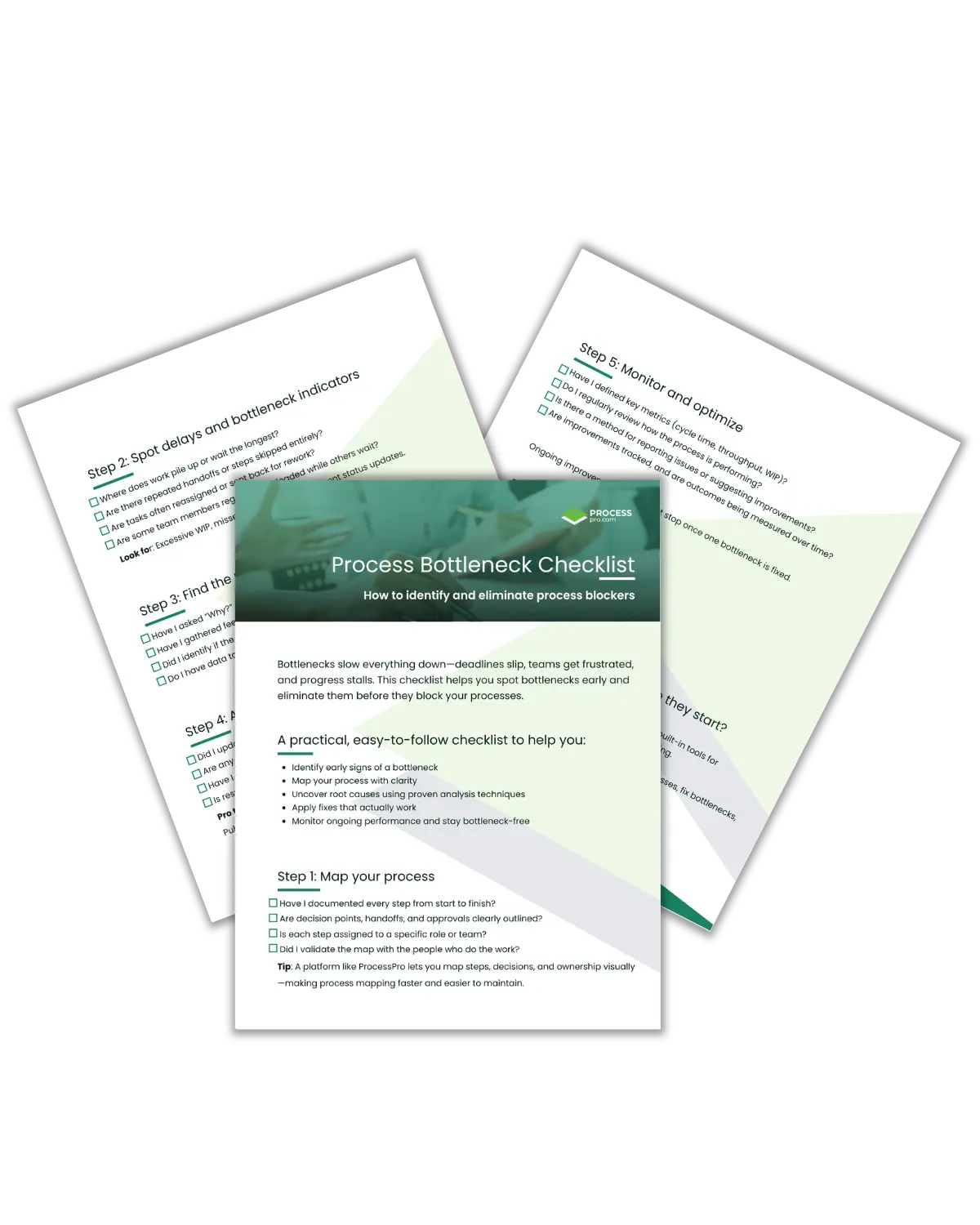Home » Fix process bottlenecks using process mapping
Business Process Management
Fix process bottlenecks using process mapping
Process bottlenecks disrupt momentum. They delay work, frustrate your team, and block progress before it starts. When one step takes too long, process bottlenecks form and everything backs up.
The good news? Bottlenecks can be fixed. With the right tools and a clear business process mapping strategy, you can spot and eliminate them before they grow into bigger problems. In this guide, we’ll walk through five simple steps to help you identify and fix process bottlenecks using process mapping.
What is a process bottleneck?
A process bottleneck is a step in your process where things slow down. It happens when a task, team, or system can’t keep up. That delay affects everything that follows.
Think of traffic on the highway. Everything moves well until one lane closes. Suddenly, the whole system slows. That’s a bottleneck in action.
How process mapping reveals bottlenecks
Process mapping shows how work moves through your team or department. It helps you find slow steps, delays, and areas where tasks pile up.
Tools like process maps, swimlane diagrams, and value stream maps make it easy. You can spot problems early and fix them before they grow.
Common causes of process bottlenecks
Bottlenecks often come from:
- Manual tasks like approvals or data entry
- Old systems that can’t handle the work
- Overloaded or understaffed teams
- Missing steps or unclear roles
Some process bottlenecks are short-term. Others are built into the process and need a long-term fix.
Constraints vs. Bottlenecks: What’s the difference?
A constraint is anything that limits how much work gets done. It becomes a bottleneck when it blocks progress.
Mapping your process helps you see both. You can then adjust or remove process bottlenecks and whatever else is slowing things down.
5 Steps to identify and eliminate process bottlenecks
Here’s a simple, step-by-step way to find and fix bottlenecks using process mapping. ProcessPro gives you everything you need to fix process bottlenecks fast. With built-in process mapping features for mapping, monitoring, collaboration, and improvement, it helps you spot issues early, address the root cause, and keep your operations running smoothly.
Download the Process Bottleneck Checklist – just enter your name and email to get instant access.

Want a step-by-step checklist to help you spot and fix bottlenecks in your own team?
Download our free Process Bottleneck Checklist, a practical PDF guide that walks you through each step covered in this post. Identify early signs of process slowdowns:
- Map your workflow clearly and accurately
- Get to the root of recurring delays
- Apply targeted fixes that work
- Monitor and stay bottleneck-free
Step 1: Map out the entire process
Start by writing down every step in your process from beginning to end. Include what happens, who does it, and what triggers each step. Don’t worry about perfection, just get the flow on paper. Include decisions, handoffs, and approvals. The goal is to create a clear picture of how work moves through your team or department.
If you’re using ProcessPro, Activities are the building blocks of your map. They clearly define each step and can include instructions, role assignments, notes, and even file attachments. Use Decisions for points where the path splits based on a yes/no outcome, and Gateways to model more complex routing, like multiple possible outcomes or conditional logic.
Want to make changes without disrupting live processes? Future State lets you redesign in the background and publish when you’re ready, ensuring a smooth transition. And for a broader view, Value Streams let you map how entire teams or departments connect, helping you understand the full end-to-end process, not just isolated steps.
All of this is managed in a cloud-based environment, so your team can build and edit collaboratively, without relying on IT or managing versions manually.
Step 2: Spot delays and bottleneck indicators
Next, look at your mapped process and ask:
- Where does work pile up?
- Where do people wait the longest?
- Which steps cause confusion or get skipped?
These are signs of a bottleneck, especially if they involve repeated handoffs, duplicated work, or constant clarification requests.
Discover how AI tools for process mapping can help teams identify bottlenecks faster and refine processes with greater accuracy.
In ProcessPro, Statuses help you see where each process sits: draft, awaiting approval, overdue, or published. Color-coded indicators make delays obvious. The Dashboard gives each user a tailored overview of tasks, reviews, and anything requiring their attention.
To dig deeper, use Historical Records to trace how processes evolved over time – spotting patterns like recurring process bottlenecks, slowdowns, or repeatedly changed steps. And if your bottlenecks involve cross-team dependencies, Value Streams help you pinpoint delays between departments, not just within them.
Step 3: Find the root cause
After you’ve spotted a bottleneck, don’t just treat the symptom, get to the root. This means having honest conversations with team members and asking “why?” repeatedly until you uncover what’s really going wrong. Is it a missing instruction? An overwhelmed role? A tool that’s no longer fit for purpose.
With ProcessPro, you can use Notes to flag exceptions, risks, or special cases directly on the map where they occur, keeping context clear. For input beyond your core team, use Feedback to collect real-time suggestions and questions, and Request Details to ask for specific information from internal or external contributors, no login required.
To back it up with data, use Reports to uncover patterns like frequent delays or bottleneck recurrence. Time and Cost Analysis helps quantify the impact of a problem, whether it’s lost time, inefficient resource allocation, or cost overruns, so you can prioritize the right fix.
Step 4: Apply simple, targeted fixes
Now that you know the problem, fix only what’s necessary. You might:
- Assign ownership more clearly
- Reduce unnecessary approvals
- Split tasks across roles
- Clarify the process to avoid confusion
In ProcessPro, these changes are easy to implement and maintain. Tasks and Notifications make sure that new actions are assigned and tracked, keeping nothing from slipping through the cracks. The Role-Based System makes it easy to reassign responsibilities without editing every step individually, perfect when teams shift or grow.
To avoid delays in sign-off, Publish with Approval gives you a structured, sequential review process where approvers are automatically prompted in the right order. And when you need to update documentation, Managed Documents ensures that new SOPs, checklists, or policies are linked directly to the relevant steps, keeping everything current and connected.
Step 5: Keep monitoring and improving
Fixing a bottleneck isn’t the finish line. Things change, and new issues can pop up. Monitor how the process runs after your fix. Are delays still happening? Has the work improved? What are people saying?
With ProcessPro, you can stay ahead of problems using Reports that track cycle time, task status, approvals, and more. You can monitor specific metrics to make sure improvements are working, or detect new problem areas before they escalate.
Need to gather updates or flag issues as they emerge? Use Request Details to collect structured input at any point, or Shared Links to involve external reviewers or stakeholders without giving them full system access.
If you want to evaluate the long-term value of your fixes, Time and Cost Analysis lets you measure improvements over time: comparing versions, projecting cost savings, or highlighting areas where you could improve further.
Process bottleneck examples
Project Management:
Slow approvals or overloaded managers.
Manufacturing:
Machine downtime or supply issues.
Service Teams:
Backlogs in support or slow onboarding.
In all cases, mapping the process shows where work gets stuck, and how to fix it.
Why process bottlenecks hurt performance
If you don’t fix bottlenecks, things get worse:
- Costs rise due to delays and overtime
- Teams burn out and morale drops
- Deadlines slip, and customers get frustrated
- You lose flexibility to adapt to change
Fixing bottlenecks protects your people, your timelines, and your bottom line.
Now that you know how bottlenecks hurt your team, let’s look at how to stay ahead of them, before they return.
How ProcessPro helps you stay ahead of process bottlenecks
Fixing a bottleneck is one thing, keeping it from coming back is another. ProcessPro doesn’t just help you map out and solve process issues; it gives you the structure to prevent them long-term.
Here’s how ProcessPro keeps your team in control
- Visual process maps that reveal slowdowns before they escalate
- Role-based responsibilities that adapt easily as teams evolv
- Automated tasks and approvals that reduce delays and manual errors
- Real-time dashboards, alerts, and reports that flag issues as they emerge
With everything working together in one cloud-based platform, ProcessPro helps you build processes that stay efficient and free of process bottlenecks, even as your business grows or changes.
Want to see how ProcessPro helps eliminate your biggest bottlenecks?
Frequently asked questions about process bottlenecks
What’s a process bottleneck?
It’s a step in a process that slows everything down because it can’t keep up with the work.
How do I find process bottlenecks?
Look for delays, task queues, and repeated slowdowns. Use process maps to spot the problem areas.
What causes process bottlenecks?
• Manual tasks
• Old systems
• Unclear steps
• Overwhelmed teams
How do I fix process bottlenecks?
Use better tools, and clearer processes. Tools like ProcessPro help you apply changes quickly and eliminate process bottlenecks.
Don’t let slow steps derail your team.

James Ross
Founder & CEO. James is passionate about all thing Process Mapping and sharing his wealth of experience with his valued clients. He works closely with his teams to ensure that ProcessPro solves real everyday process mapping problems.
Share this article
